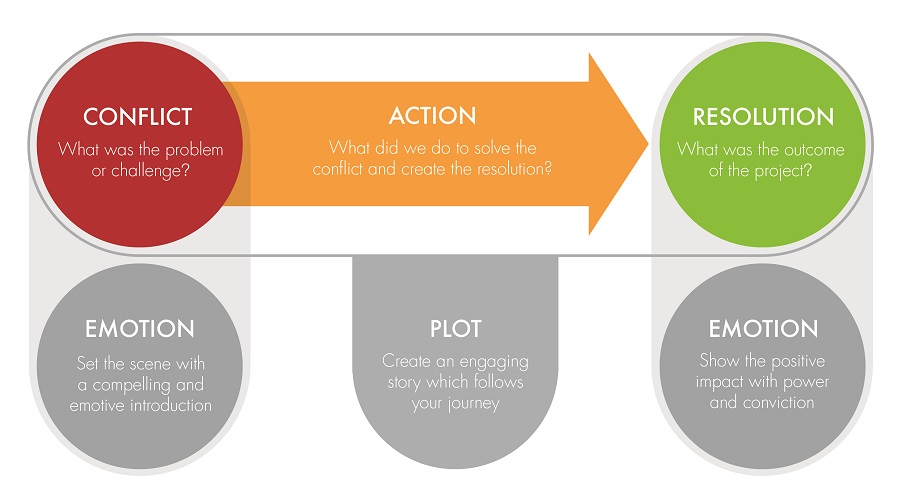The art of storytelling in clinical data communication − what we can learn from Batman and the Joker?

What can we learn from Batman and the Joker, the greatest hero/villain pairing of all time? Their co-dependent relationship has led to some incredible pieces of storytelling that continue to live long in the minds of their audience; because stories are one of the most powerful forms of communication. A story, when broken down into its simplest form, is a connection between cause and effect. Our decisions and behaviours are based on stories – the stories people tell themselves or the ones that others tell them. So how can we harness the power of storytelling to effectively communicate clinical data?
Clinical data is fundamental to clinicians’ medical education and clinical practice, and should be the starting point for evidence-based improvements in how patients are treated. However, communicating clinical data alone isn’t enough to change the behaviour of healthcare professionals (HCPs) because facts and figures may be easily retained by computers, but not by people.
If we are to have any success in bridging this gap between clinical data and clinical practice, we have to do more than just exchange information. Effective communication strategies should not only understand the challenges and the impact on the audience, but the solutions provided should also appeal to both hearts and minds or, to put it another way, to our behaviour.
Behavioural science demonstrates that provoking an emotional response will have a more persuasive effect than communicating logic and data alone; and being able to encapsulate an emotional narrative within a medical communications programme will help to accelerate behavioural change in clinicians that will ultimately benefit patients.
Heart versus head: do you understand how HCPs think?
Having an understanding of how people think, and the underlying emotions that influence their behaviours, provides invaluable insights that can help shape our communication initiatives.
Daniel Kahneman, in his book ‘Thinking, Fast & Slow’, sees human thinking in two forms; System 1 (intuitive/emotional) and System 2 (reflective/logical). According to Kahneman’s description:
‘System 1 operates automatically and quickly, with little or no effort and no sense of voluntary control.’ For example, when you’re driving or walking to a friend’s house, you’re on autopilot and don’t consciously think about which route to take. This previously learned behaviour is not something that demands strategic thinking.
‘System 2 allocates attention to the effortful mental activities that demand it, including complex computations.’ For example, this may include remembering an event that occurred a few weeks ago, working out a maths problem or checking whether an argument is logically valid.
Decisions are largely made using autopilot (System 1), which helps us act quickly and efficiently… but this is prone to predictable errors. So, although System 2 sometimes over-rides judgements made by System 1, Kahneman explains that System 2 can be ‘lazy’, allowing System 1 to lead us to irrational conclusions.
Captivate your audience with an engaging story that they will remember and act on
So, how can we engage System 1 thinking when communicating scientific data? One approach is through storytelling, which can have a lasting impact, but how?
Stories help us relate, they allow us to empathise and enable our brains to process information in a form that is more digestible and memorable. Stories also provide the connections between simple facts. Research shows that when data are embedded in a story, it is more effectively emotionalised and metabolised by the listener – and it becomes more actionable.
A good story helps engage interest on an emotional level (via System 1) and subsequently encourages reflective thinking (via System 2), providing the key stimulus for behaviour change.
For some people, crafting a story around the data may seem like an unnecessary time-consuming effort. They may feel that the facts should be sufficient to stand on their own as long as they’re reported in a clear manner, believing that this will influence the right decisions and drive their audience to act. Unfortunately, this point of view is based on the flawed assumption that clinical decisions are based solely on logic and reason – System 2 thinking!
If the emotional aspects of System 1 thinking can be harnessed as part of a medical education campaign, this will likely enhance the impact and effectiveness by deepening the audience’s understanding and engagement with the educational messages. This emotional connection is more likely to lead to positive action.
What does a good story look like?
If you had to distil a good story down into its key components, there would be a captivating conflict and a satisfying resolution. Any good story builds up a conflict that is, in the end, resolved to a greater or lesser extent. The higher the stakes of the conflict, the more interesting the story and more satisfying the resolution.

But where do these elements of a story fit within the processes of scientific research and medical education? We can draw parallels with well-known stories, even those from comic books, where there is a notable conflict/antagonist (terror wrought by our villain the Joker) and a resolution/protagonist (our hero Batman saves the day). In a scientific communication, the aim is to set the scene by explaining the conflict (clinical issue or unmet need) in such a compelling way that the reader wants to know the outcome. This could be achieved by focusing on what is at stake for the patient (perhaps feelings of frustration or desperation due to their disease). Structuring the story to build upon the facts using appropriate language to add tension and bring in emotion will grab the reader’s attention. The plot unfolds, with a description of the methods employed to tackle the conflict and the results generated. Ultimately, the story concludes with the resolution; how the results meet the previously stated need and what this actually means for the patient (perhaps feelings of liberation and renewed hope for the future).
Determining how to communicate clinical data in peer-reviewed publications requires skilful judgement that strikes the right rational and emotional balance. Finding the right story in the data will require a ‘narrative process’, but the story can only ever be as good as the data on which it is based. For example, effectively communicating the burden of the disease and the real physical and emotional impact this has for the patient is vital for the emotional impact. However, to balance this important message the factual, quality-of-life data is a critical component of the story, particularly in today’s metric-centric world.
As authors, we are responsible for translating the insights we have on our data into a meaningful and clear story that resonates with the audience, making it relevant and actionable. If we do not engage the reader, our messages will never be heard, let alone believed, and we will fail to change behaviour.
This is not ‘The End’
Storytelling has been shown to be a powerful approach for sharing data and ideas in a way that is memorable, persuasive and engaging. This is particularly important in a world where the volume of information is ever increasing, the needs of patients are increasingly complex and healthcare systems have undergone seismic shifts. The need for more effective communications that cut through the data to connect with HCPs on an emotional level has never been greater!
About the author
[caption id="attachment_47815" align="alignleft" width="129"] Angela Ward[/caption]
Angela Ward[/caption]
Angela Ward is a Senior Client Service Director at Complete HealthVizion, an innovative medical communications and strategic consultancy within the McCann Health network. In her current role, Angela provides strategic guidance to clients, helping to deliver a wide range of impactful medical communication services that make a positive difference to patients’ lives. She can be contacted at: Angela.Ward@complete-hv.com
To find out more about Complete HealthVizion please click here.











